Book Excerpt: Coffee House of Lahore by KK Aziz
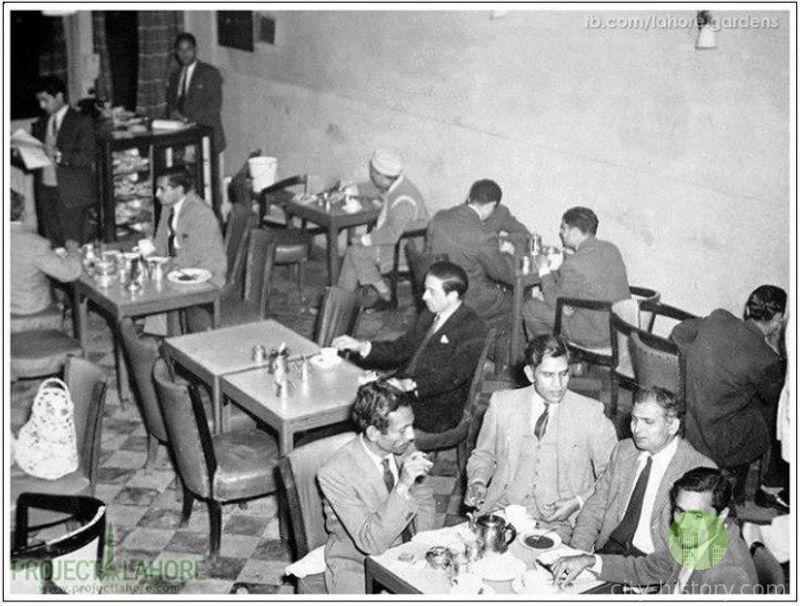 From the 1920s onwards, perhaps since event earlier, Lahore was the most highly cultured city of north India. From here appeared the largest number of Urdu literary journals, newspapers and books and two of the best English language dailies. The Mayo School of Arts was flourishing. The Young Men Christian Association was active and its premises and hall were used by all communities for literary and social activities. The Government College was a distinguished intellectual centre whose teachers were respected and students considered to be the best representatives of modern Western education. The Oriental College was engaged in first class research. The annual plays staged at Government College and Dyal Singh College were awaited by the city’s elite with high expectations. Eminent journalists and columnists wrote for newspapers and graced literary gatherings. The city rang with the echoes of the poetry of Faiz Ahmad Faiz, Noon Meem Rashed, Hafeez Jullunderi and Akhtar Shirani. The Niazmandan-i-Lahore, the magic circle of A.S. Bokhari, M.D. Taseer, Hafeez Jullandheri, Sufi Tabassum, Syed Imtiaz Ali Taj and Hari Chand Akhtar, created enormous waves in the world of Urdu literature.
From the 1920s onwards, perhaps since event earlier, Lahore was the most highly cultured city of north India. From here appeared the largest number of Urdu literary journals, newspapers and books and two of the best English language dailies. The Mayo School of Arts was flourishing. The Young Men Christian Association was active and its premises and hall were used by all communities for literary and social activities. The Government College was a distinguished intellectual centre whose teachers were respected and students considered to be the best representatives of modern Western education. The Oriental College was engaged in first class research. The annual plays staged at Government College and Dyal Singh College were awaited by the city’s elite with high expectations. Eminent journalists and columnists wrote for newspapers and graced literary gatherings. The city rang with the echoes of the poetry of Faiz Ahmad Faiz, Noon Meem Rashed, Hafeez Jullunderi and Akhtar Shirani. The Niazmandan-i-Lahore, the magic circle of A.S. Bokhari, M.D. Taseer, Hafeez Jullandheri, Sufi Tabassum, Syed Imtiaz Ali Taj and Hari Chand Akhtar, created enormous waves in the world of Urdu literature.
The well-to-do Westernized elite drank and danced and talked in the Gymkhana and Cosmopolitan clubs. The home grown dazzling lights set off their fireworks at the Arab Hotel, Nagina Bakery, Muhkam Din’s teashop, Halqa-i-Arbab-i-Zauq, India Tea House and India Coffee House. The greatest in the land, like Tagore, came and spoke at the SPSK Hall. Political debates were held at Bradlaugh Hall, Amrita Sher Gill painted and B.C. Sanyal sculpted. The best British and American films were screened at Regal and Plaza. There was even a school of ballroom dancing on the upper storey of Regal. The baithaks in the walled city trained young musicians and singers and invited the connoisseurs to come and listen to classical music. The radio came a little later and the literati wallowed in a new channel which immediately enlarged the circulation of what they wrote, said or composed. With Bokhari’s genius presiding over the radio network, the first generation of literary broadcasters was in the making.
A glorious physical setting for this pulsating intellectual activity was provided by the Lahore that the British had built between 1860 and 1935. Impressive edifices adorned the landscape: Lawrence Hall, Chiefs’ College, Government House, High Court, Masonic Lodge, Legislative Assembly, General Post Office, Museum, Mayo School of Arts, the University, Government College and Central Training College. The queen of all roads, the Mall, was bordered by tall trees and wide footpaths, and boasted a glittering array of expensive shops. The race course and the Lawrence Gardens were the lungs of the city. No high-rise buildings existed. With no encroachments the roads looked wider. The bungalows of Davis, Empress, Egerton, Queens and Jail Roads were elegantly built and located in the middle of green lawns. The skyline was soothing. Nature’s green was the dominating colour of the city. Breathing was easy, and so was enjoying life.
Like all civilized cities, Lahore provided a wide range of restaurants where people gathered for pleasure, social interaction and intellectual gossip. The Nedous Hotel stood where Hilton was later built and still later the Avari; in it lived Abdullah Yusuf Ali who completed his translation and commentary of the Quran in one of its first-floor rooms. The serene Faletti’s was centrally located on Egerton Road, behind the assembly chamber and facing Rai Bahadur Saran Das’s mansion. Jinnah, Abul Kalam Azad and Ava Gardner stayed here. Later Sir Firoz Khan Noon made it his home.
At the corner of the present day WAPDA House, and facing the assembly chamber, was the Metro, where in summer tea was served alfresco and Miss Angela did her cabaret show. In the two hall-size rooms of the Shah Din Building was the Lorangs, the finest restaurant in town, patronized by the elite. Near it stood the Stiffles where the guests dined in dinner jackets, danced in the evening and lunched with their friends in as English an ambience as could be conceived. The Standard had its large premises next to the driveway leading to Regal Cinema and facing the Mall. Several steps lower than Stiffles and Lorangs in glory, status and prices, it catered for the middle class and was always crowded; in summer it used the large space between its building and the footpath as an open air tea house.
At the other end of this “West End” of Lahore was a cluster of humble eating places where the modest and poor intellectuals got together and stayed together for long hours, sipping coffee or tea, drinking glasses of water, and settling the problems of the world. The best of them was the India Coffee House, established by the Indian Coffee Board in the mid-1930s to popularize the drink. Next to it was the Cheney’s Lunch Home, and a hundred yards away the India Tea House. Almost next to it was the YMCA where the Halqa-i-Arbab-i-Zauq met every week. The “oriental” places drew a mixed crowd of journalists, poets and men of letters: the Arab Hotel on Railway Road opposite the Islamia College gate, the Delhi Muslim Hotel in Anarkali where Bokhari lived in the 1920s, and the Nagina Bakery at the corner of Anarkali and Nila Gumbad. To these was later added the Cecil, which was a small private business run by a Parsi family in its residence. Called “Pathraan wali Kothi” (bungalow built of stone and with tiled roofs) it was situated at the junction of Cooper and Dil Mohammad Roads, opposite today’s duty free shop. Among other places worth mentioning were the Indus Hotel, Volga and Orient on the the Mall, and Milk Bar in the Tollinton Market, and the Elphinstone, West End and bristol on McLeod Road.
The very names of these restaurants are enough proof of the Englishness of the city. This was confirmed further by the commercial establishments on both sides of the Mall, some of which survived British withdrawal.
Whiteway Laidlaw, the haberdashers, did business where Ferzsons now sells books. Smith and Campbell is still there, though of course under changed ownership. Rankin, at the corner of the Mall and Beadon Road, was a fashionable outfitter having the custom of the elite; it lived on for a few years after 1947. Goldsmith and Bal Moodie in the Shah Din Building, Jenn and Ellerton and Gillanders Arbuthnot are some of the shops I remember. All have disappeared.
Among the Indian shops almost all were under Hindu ownership and some of them had been opened in 1945-46, soon to be engulfed by disaster. In the Bank Square were the Sunlight Insurance, the brand new departmental story of Janki Das, and Devi Chand; on the Mall, Kirpa Ram in front of Regal; in Anarkali Narain Das Bhagwan Das ran the biggest pharmacy in town. Facing the high court building was the interesting haircutting establishment carrying the name of A.N. John. Many of the well-to-do went there under the impression that it was run by the British. Actually the owner was one Amar Nath who had added John to his initials and thus made a lot of money.
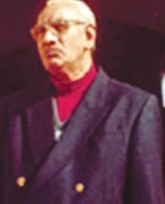 Khursheed Kamal Aziz (KK Aziz)
Khursheed Kamal Aziz (KK Aziz)
Khursheed Kamal Aziz (11 December 1927, Ballamabad, British India – 15 July 2009, Lahore, Pakistan) better known as K. K. Aziz, was a Pakistani historian, admired for his books written in the English Language. However, he also wrote Urdu prose and was a staunch believer in the importance of the Persian language
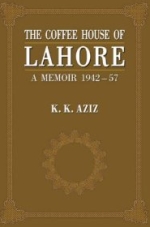 The Coffee House of Lahore: A Memoir
The Coffee House of Lahore: A Memoir
K. K. Aziz
Before his death in July 2009, KK Aziz had accomplished one mission that he had set for himself, i.e. to write about the Lahore Coffee House, the glorious nursery of ideas. Luckily, despite his failing health, Aziz finished a draft that was meant to be a shining part of his autobiographical kaleidoscope.
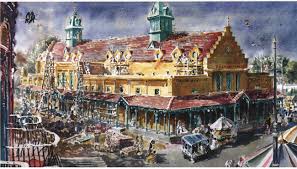 KK Aziz and the Coffee House of Lahore: Chris Moffat
KK Aziz and the Coffee House of Lahore: Chris Moffat
During a recent trip to Lahore, I visited the Sang-e-Meel bookshop on Lower Mall Road in search of K.K. Aziz’s The Coffee House of Lahore. Happily, the store was well stocked with the late historian’s final work, and I spent the afternoon reading the text at a table outside the nearby Tollinton Market.
 Book Excerpt: Coffee House of Lahore by KK Aziz
Book Excerpt: Coffee House of Lahore by KK Aziz
the 1920s onwards, perhaps since event earlier, Lahore was the most highly cultured city of north India. From here appeared the largest number of Urdu literary journals, newspapers and books and two of the best English language dailies. The Mayo School of Arts was flourishing. The Young Men Christian Association was active and its premises and hall were used by all communities for literary and social activities.
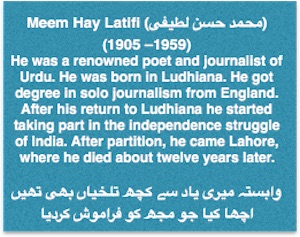 Muhammad Hasan Latifi: The Coffee House of Lahore by KK Aziz
Muhammad Hasan Latifi: The Coffee House of Lahore by KK Aziz
He was one of those remarkable men who arrived in Lahore in 1947 as a part of the flotsam & jetsam of the partition of the Punjab. His acute sufferings began with the ravages of the great migration & ended with his death 12 years later. The story of his life needs to be told in some detail.
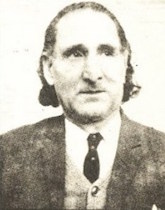 Zaheer Kashmiri: The Coffee House of Lahore by KK Aziz
Zaheer Kashmiri: The Coffee House of Lahore by KK Aziz
A flamboyant personality, consciously outrageous, bent upon having his say on the subject of his choice, and colourful in his deportment and dress. but all this served as an outer cover (perhaps a disguise) for a heart palpitating on the plight of the oppressed and a soul full of fellowship in sorrow… As an Urdu poet his reputation stands high.
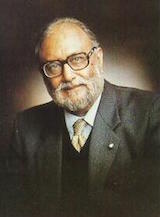 Dr. Abdus Salam: The Coffee House of Lahore By K K Aziz
Dr. Abdus Salam: The Coffee House of Lahore By K K Aziz
Among my contemporaries and colleagues in Government College, companions in the Coffee House of Lahore and friends at these places and elsewhere there is only one genius, and that was Abdus Salam. Salam was the son of Chaudhri Muhammad Husain, a schoolteacher of Jhang and Hajirah who belonged to Faizullah Chak near Batala Muhammad Husain was a jat and Hajirah a Kakkezai.
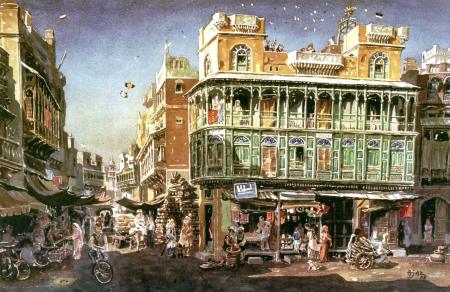 Arab Hotel Lahore: KK Aziz and A Hameed
Arab Hotel Lahore: KK Aziz and A Hameed
No description of the cultural life of Lahore can be complete without mentioning the Arab Hotel. Once the old-fashioned baithaks (sitting rooms of the orient) had gone out f use, the literati wanted a pace where they could meet, eat and talk. For those ‘orientalists’ of the 1920s the Mall was too Westernized, distant and costly. By chance they started patronizing a small, unclean restaurant on Railway Road, opposite the gate of the Islamia College.
